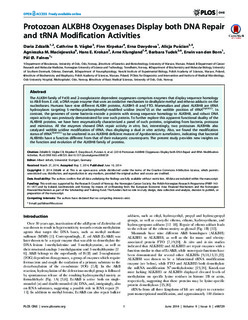Protozoan ALKBH8 Oxygenases Display both DNA Repair and tRNA Modification Activities
Zdzalik, Daria; Vågbø, Cathrine Broberg; Kirpekar, F; Davydova, Erna; Puścian, Alicja; Maciejewska, Agnieszka M.; Krokan, Hans Einar; Klungland, Arne; Tudek, Barbara; Van den Born, Erwin; Falnes, Pål
Journal article, Peer reviewed
Permanent lenke
http://hdl.handle.net/11250/299788Utgivelsesdato
2014Metadata
Vis full innførselSamlinger
Sammendrag
The ALKBH family of Fe(II) and 2-oxoglutarate dependent oxygenases comprises enzymes that display sequence homology
to AlkB from E. coli, a DNA repair enzyme that uses an oxidative mechanism to dealkylate methyl and etheno adducts on the
nucleobases. Humans have nine different ALKBH proteins, ALKBH1–8 and FTO. Mammalian and plant ALKBH8 are tRNA
hydroxylases targeting 5-methoxycarbonylmethyl-modified uridine (mcm5U) at the wobble position of tRNAGly(UCC). In
contrast, the genomes of some bacteria encode a protein with strong sequence homology to ALKBH8, and robust DNA
repair activity was previously demonstrated for one such protein. To further explore this apparent functional duality of the
ALKBH8 proteins, we have here enzymatically characterized a panel of such proteins, originating from bacteria, protozoa
and mimivirus. All the enzymes showed DNA repair activity in vitro, but, interestingly, two protozoan ALKBH8s also
catalyzed wobble uridine modification of tRNA, thus displaying a dual in vitro activity. Also, we found the modification
status of tRNAGly(UCC) to be unaltered in an ALKBH8 deficient mutant of Agrobacterium tumefaciens, indicating that bacterial
ALKBH8s have a function different from that of their eukaryotic counterparts. The present study provides new insights on
the function and evolution of the ALKBH8 family of proteins.
